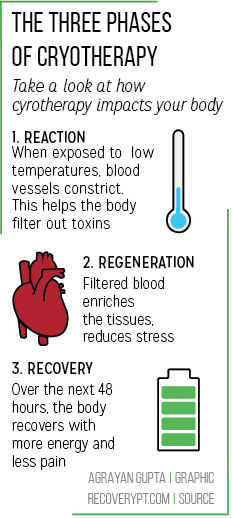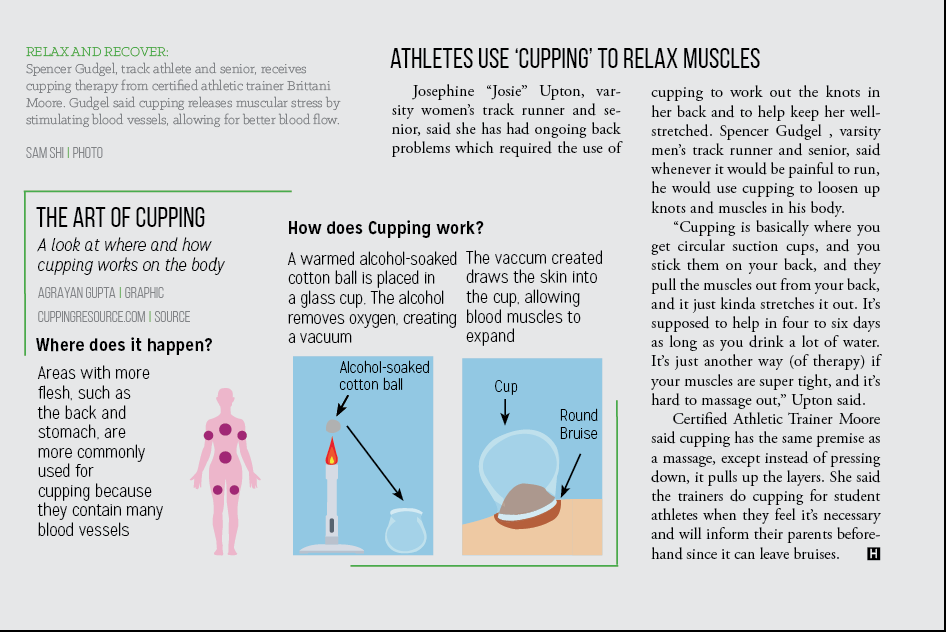Spencer Gudgel, varsity men’s track runner and senior, said he is a fan of cryotherapy.
Gudgel said during his freshman and sophomore years, he was recovering from a hamstring hip issue, and to recover he went to physical therapy through IU Health, then later switched to St. Vincent. He said after completing all of his therapy there, he focused on maintaining his health, which led him to cryotherapy at ABY (A Better You) Wellness.

Ben Underwood, track athlete and senior, stands in an ice bath after practice. Underwood said he does the ice baths before cross country and track meets because it helps keep his legs fresh.
Sam Shi | Photo
Gudgel said, “Since my seasons are long for running—I compete 11 months out of the 12—it takes a toll on (my) body. Cryotherapy just kind of refreshed it and made my body feel a lot better. I do ice baths usually when summer hits before every race and when it’s winter I do an epsom salt bath, which is basically the same thing, just warm water and salt that helps relax your body.”
Cryotherapy uses cold temperatures to help relieve muscle pain, sprains and swelling, but although Egyptians as far back as 2,500 BCE used cold techniques, modern cryotherapy is a relatively new trend.
Certified athletic trainer Brittani Moore said cryotherapy has become more popular because it’s a “fad” for athletes right now. She said the school has been using cryotherapy for a long time, but with new technology people are starting to look into different types of cryotherapy to see whether it is effective or not.
Moore said, “Cryotherapy is using cold; anything cryo- means pretty much cold therapy. It restricts blood flow and helps reduce some of the inflammatory response after big injuries. It’s usually used for people who are injured, so like ankle sprains and things of that nature, so if they have an injury and they went and did a hard workout, it’s to recover for that.”
Moore said school trainers will normally give ice baths to student athletes when they are calming down after an activity. She said there is a large variety of student athletes who receive therapy from this school for every season. Moore said since she often saw more student athletes turn to ice baths during the summer, the trainers would leave baths in the parking lot for students to utilize. She said although the technique is more common during the summer, she’ll still see students taking ice baths during the winter depending on the sport the student athlete participates in and how the student feels.
Ben Underwood, varsity men’s track runner and senior, is one of those athletes.
He said, “I’ll typically do ice baths before a big work out and big races. In cross-country, we typically did it towards the end of the season, maybe once a week or once every other week, and then during track it’s more sporadic because meets are more spread out. It helps because it makes my legs feel fresher and then I feel better for the run the next day. Part of it is mental; it gives me like a confidence boost just because it’s worked in the past, so it’ll most likely work in the future, too.”
Josephine “Josie” Upton, varsity women’s track runner and senior, said she has had ongoing shin splints which caused stress fractures last year. Additionally, Upton has strained her hamstrings in races.
“Cryotherapy is more along the lines of being in really cold temperatures. It’s almost like ice baths, except you don’t have to get in the water and it’s better than just having ice packs on your back because it’s more effective (and) it covers a larger area. It brings down the swelling a lot and it helps soothe the muscles that are super tight,” Upton said.
Moore said there are a lot of professional athletes who use extreme measures of cryotherapy, and when students see someone famous using a form of therapy, whether it has been proven to work or not, they tend to utilize it too. She said it can work as a placebo effect.
However, athletes should consider other factors of cryotherapy and other cold treatments before they try them.
Colin Altevogt, assistant coach for the men’s track team said, “Especially for endurance sports, some of the research on ice baths say that it’s not as good as we thought it would be. When you train and you run and you impact the ground, in your muscles, there’s a certain amount of inflammation, and it might be better for your body to naturally handle the inflammation rather than doing ice baths.”































![British royalty are American celebrities [opinion]](https://hilite.org/wp-content/uploads/2024/03/Screenshot-2024-03-24-1.44.57-PM.png)




















![Review: “The Iron Claw” cannot get enough praise [MUSE]](https://hilite.org/wp-content/uploads/2024/04/unnamed.png)
![Review: “The Bear” sets an unbelievably high bar for future comedy shows [MUSE]](https://hilite.org/wp-content/uploads/2024/03/unnamed.png)
![Review: “Mysterious Lotus Casebook” is an amazing historical Chinese drama [MUSE]](https://hilite.org/wp-content/uploads/2024/03/0.webp)
![Thea Bendaly on her Instagram-run crochet shop [Biz Buzz]](https://hilite.org/wp-content/uploads/2024/03/IMG_0165-1200x838.jpg)
![Review: Sally Rooney’s “Normal People,” is the best book to read when you are in a time of change [MUSE]](https://hilite.org/wp-content/uploads/2024/03/20047217-low_res-normal-people.webp)
![Review in Print: Maripaz Villar brings a delightfully unique style to the world of WEBTOON [MUSE]](https://hilite.org/wp-content/uploads/2023/12/maripazcover-1200x960.jpg)
![Review: “The Sword of Kaigen” is a masterpiece [MUSE]](https://hilite.org/wp-content/uploads/2023/11/Screenshot-2023-11-26-201051.png)
![Review: Gateron Oil Kings, great linear switches, okay price [MUSE]](https://hilite.org/wp-content/uploads/2023/11/Screenshot-2023-11-26-200553.png)
![Review: “A Haunting in Venice” is a significant improvement from other Agatha Christie adaptations [MUSE]](https://hilite.org/wp-content/uploads/2023/11/e7ee2938a6d422669771bce6d8088521.jpg)
![Review: A Thanksgiving story from elementary school, still just as interesting [MUSE]](https://hilite.org/wp-content/uploads/2023/11/Screenshot-2023-11-26-195514-987x1200.png)
![Review: When I Fly Towards You, cute, uplifting youth drama [MUSE]](https://hilite.org/wp-content/uploads/2023/09/When-I-Fly-Towards-You-Chinese-drama.png)
![Postcards from Muse: Hawaii Travel Diary [MUSE]](https://hilite.org/wp-content/uploads/2023/09/My-project-1-1200x1200.jpg)
![Review: Ladybug & Cat Noir: The Movie, departure from original show [MUSE]](https://hilite.org/wp-content/uploads/2023/09/Ladybug__Cat_Noir_-_The_Movie_poster.jpg)
![Review in Print: Hidden Love is the cute, uplifting drama everyone needs [MUSE]](https://hilite.org/wp-content/uploads/2023/09/hiddenlovecover-e1693597208225-1030x1200.png)
![Review in Print: Heartstopper is the heartwarming queer romance we all need [MUSE]](https://hilite.org/wp-content/uploads/2023/08/museheartstoppercover-1200x654.png)























![Review: Ladybug & Cat Noir: The Movie, departure from original show [MUSE]](https://hilite.org/wp-content/uploads/2023/09/Ladybug__Cat_Noir_-_The_Movie_poster-221x300.jpg)

![Review: Next in Fashion season two survives changes, becomes a valuable pop culture artifact [MUSE]](https://hilite.org/wp-content/uploads/2023/03/Screen-Shot-2023-03-09-at-11.05.05-AM-300x214.png)
![Review: Is The Stormlight Archive worth it? [MUSE]](https://hilite.org/wp-content/uploads/2023/10/unnamed-1-184x300.png)






